This is the third in a series on New Hampshire skiing in the age of climate change. You can find the introduction here and the second article, on the challenges facing the state’s smaller downhill areas, here.
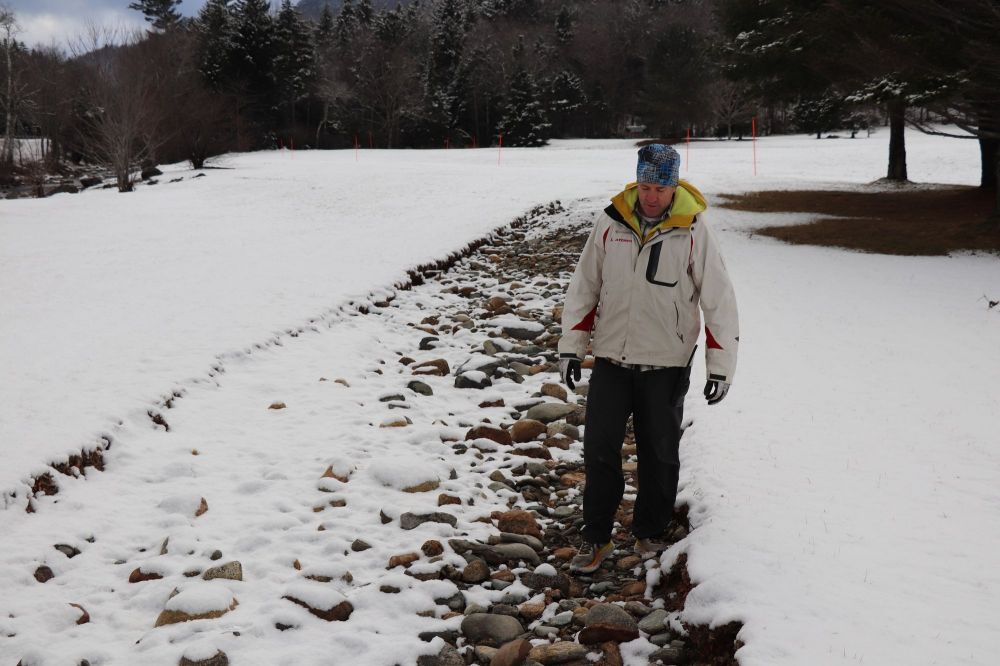
Great Glen Program Director Nate Harvey walks along a trail that was washed out by the December 18th floods. Its rocky base was carefully engineered to allow for more consistent skiing in low-snow conditions. (Photo: Beatrice Burack)
When Gorham’s Great Glen Trails first opened in December of 1994, a low-snow winter almost stopped the cross-country center in its tracks. “We barely got off the ground,” says Nate Harvey, the nordic area’s retail manager and program director. Great Glen installed a snowmaking system in the winter of ‘95, and has been making snow ever since.
Harvey thinks Great Glen’s trails are located at a high enough elevation to stay viable as winters warm, but he points to numerous changes he and his colleagues are making to stay ahead of the climate curve.
One change that’s underfoot—literally—has to do with how the trails are constructed. To build Great Glen’s 14-foot-wide trails, construction crews dug up dirt, replacing it with a mixture of stone and gravel. These trails are resistant to erosion (though mid-December flooding put them to the test this year), and have fewer sticks and roots that need to be covered by snow.
“Because we’ve got so much invested in how the trails are built, it doesn’t take a lot of snow to open us,” Harvey says. “With six to eight inches of the right snow, we can groom that out and be open with almost 90 percent of our trails.”
In addition to engineering the trails for low-snow conditions, Harvey and his crew practice what he calls “snow farming.” Picture employees harvesting snow from unsalted parking lots, shoveling it into sleds and trucks, and spreading it out on the trails.
At Great Glen Trails, there have also been changes to the snowmaking process. They still need 24 hours of the right conditions—below 24 degrees, preferably with low humidity and low wind—to efficiently make snow. But while the center used to look at multi-day weather forecasts before deciding if it was worth it to blow snow in those 24-hour windows, Harvey says that nowadays, they’ll blow snow no matter what: “Now we have to take every opportunity when we’ve got that 24-hour-plus window of cold to do it, because you don’t know when the next one is.”
Great Glen’s increased reliance on snowmaking was on full display this season. Their trails were open during the snowy stretch in the first week of December, Harvey says, with help from “a tiny bit of man-made snow.” But by mid-December rain had taken away much of the snow, and the center had just a short, half-kilometer loop of entirely man-made snow open for weekend ski lessons.
“It’s not really what most people are after when they think of skiing in New England,” Harvey says. “They want to feel the stroll through the woods, but it’s just little bits and pieces of skiing here and there.”
The center has 45 kilometers of skiable trails. According to their website, only a quarter-kilometer of terrain was open the Thursday after Christmas—usually a prime time for visitors. “[W]e still have .25km of skiing—a nice ‘white ribbon’ for you to enjoy for $10,” the snow report read that day.
Christmas week, along with Martin Luther King Day weekend and February vacation, is one of three high-revenue periods that Harvey says “can really make the whole season, or break ‘em.”
After the Flood in Jackson
On December 18th, Jackson, New Hampshire made national news when the Ellis River, swollen with rainwater, brought massive floods to the village. The Jackson Ski Touring Foundation, whose trails criss-cross the river, was hit hard by the storm.
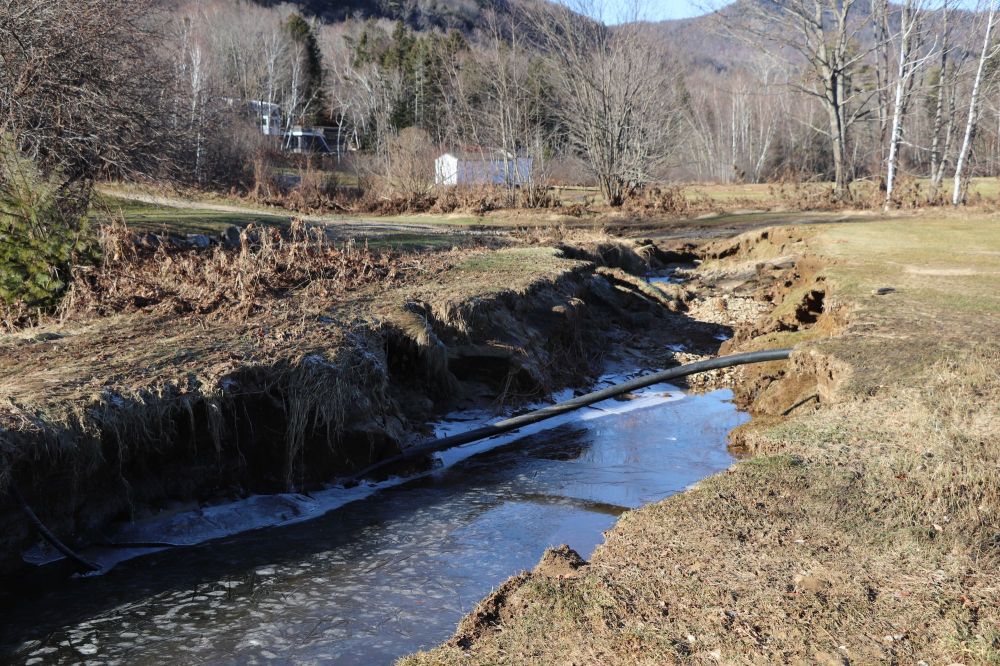 Water damage to one of the Jackson Ski Touring Foundation’s trails after the December 18th floods.(Photo: Beatrice Burack)
Water damage to one of the Jackson Ski Touring Foundation’s trails after the December 18th floods.(Photo: Beatrice Burack)
Looking out at a bridge that had been snapped off its foundation uphill of Jackson Falls, Touring Foundation board Vice President Ken Kimball managed to look on the bright side.
“This couldn’t have happened better if it was going to happen,” he said. “I’m dead serious.” If the water had been moving in a different direction, the bridge “would’ve gone right down through Jackson Falls, and that would have been catastrophic.” Board President Debony Diehl, who owns a salon down the hill, was glad it didn’t end up in her basement.
For Kimball, this flood exemplified the changes to come with climate change. “We started off with the philosophy of snowmaking and getting our trails so that they’re skiable at low snow.” But after witnessing major rain events like this one, he said, “There’s no question that we’re now going to have to start dealing with, ‘How do you prevent erosion from major runoff events?’”
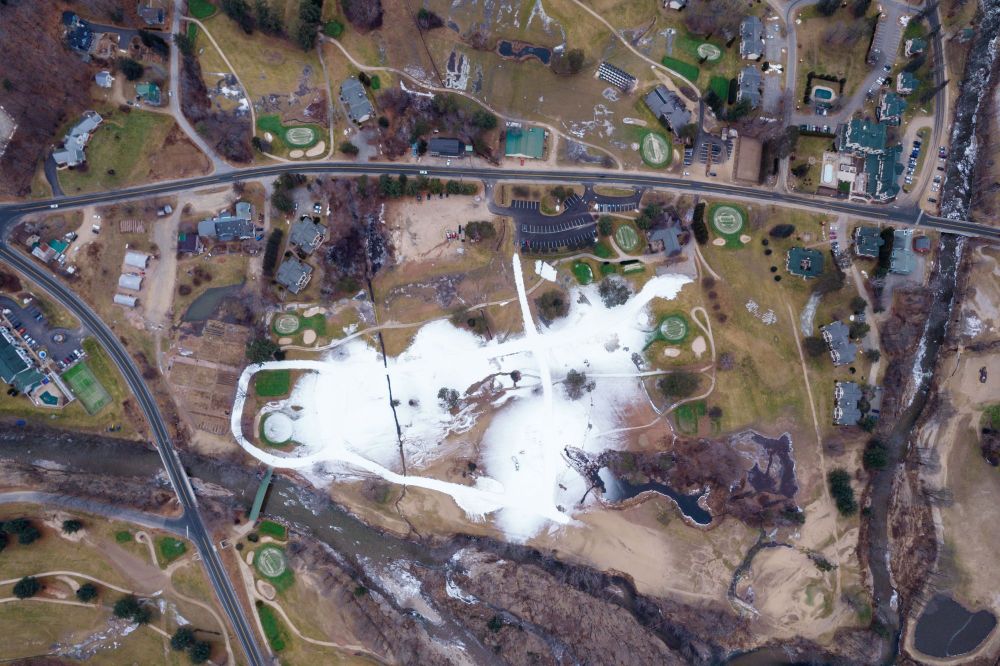
Snowmaking at Jackson in December. (Photo: Andrew Drummond/White Mountain Ski Co.)
As the floods came, the Jackson Ski Touring Foundation was in the last month of a $1.5 million capital campaign to mark its 50-year anniversary, and had raised about $1.4 million to date. When the campaign began, Kimball said, a large portion of the funds were intended to pay for a snowmaking system. “Well, that ratio may have to change,” he said after the storm.
Kimball and Diehl were talking about increasing the funding that will go to trail and bridge repair. Kimball estimated that repairs from the storm could run as high as $100,000, which is roughly an eighth of the foundation’s typical annual budget.
The timing of the flooding was especially poor, coming right before Christmas week, one of the foundation’s biggest weeks for revenue.
“You want to grab this Christmas-New Year’s break. And if we don’t get snow and we lose that part…” Kimball trailed off. “Financially, it is a huge loss that can’t be made up. That’s probably the part of the season that is just worst-case scenario for us [to lose].”
Diehl added that the board had already been planning for what they thought was a worst-case Christmas week. They were banking on having natural snow for skiing at Prospect Farm, their higher-elevation trail network, and making snow on some of their lower-elevation trails in Jackson village to “have a diversity of terrain.” That didn’t happen.
Instead, the daily trail report posted on the foundation’s site right after Christmas advertised a one-kilometer loop of man-made snow open for skiing. An aerial photo on the page showed a rough circle of white trail against a backdrop of green and brown grass.
Kimball, a cross-country ski racer throughout high school and college, has seen racecourses getting shorter. While he used to ski long races along a single trail without having to loop back, he now sees racers doing multiple laps on a smaller trail until the loops add up to 10, 15, or 20 kilometers.
Some racers don’t mind this, he says, but many recreational skiers are looking to get more of a scenic view when they ski. “I think, for the general skier, they want to get out and tour, they’re not interested in the gerbil loop of just round and round and round.”
“But we’re convincing them otherwise. We’re demonstrating other opportunities,” adds Executive Director Ellen Chandler. Chandler notes that making smaller loops of man-made snow early in the season is critical for keeping skiers interested in the sport and for giving new skiers an opportunity to learn.
“We want to get them on snow. They want to go skiing in December, and we want to provide that for them so that way, they’ll stay all winter,” she says.
Building for the Future
On the other side of the White Mountains, in Hanover, the Oak Hill Outdoor Center would have been happy to open even a small strip of snow open in December. Peter Milliken and Matt Rightmire, chairman and treasurer of the nonprofit Friends of Oak Hill, have been working since 2022 to retrofit their ski trails for warmer winters and were finally able to open Oak Hill for the season in January.
The Oak Hill project, financed by a 50/50 split between community donors and Dartmouth College—which owns much of the land—is an ambitious $5.2 million two-year project to build new trails, add lights and a warming hut, and put in snowmaking at the center.
Rightmire says there have been conversations about putting in snowmaking at Oak Hill since at least the ‘90s, so the appetite for the project was already there.
“We didn’t have to convince them of the need. Anybody that had been around here for the last seven to 10 years knew that the season was getting shorter, that the quality of the snow that they were skiing on was highly variable,” he says.
He and Milliken were able to raise their half of the $5.2 million in about a year, and Dartmouth did the same.
For Rightmire and Milliken, whose children grew up skiing at Oak Hill through the Ford Sayre Ski Club, the investment will be worth it if helps maintain the club’s tight-knit skiing community. “We have so many kids interested, we have so many parents that are willing to volunteer, we have amazing ski culture in this community. But without snow, you’re kind of out of luck,” says Milliken.
Annie Hanna, a sophomore at Lebanon High School and a member of Ford Sayre’s Junior Nordic Team, was overjoyed to hear that a nordic center so close to home was investing in snowmaking.
Hanna and her Ford Sayre teammates spend much of their winters chasing snow. Their rule of thumb: however long they spend driving to their destination, that’s at least how long they should spend skiing there. “But,” says Hanna, “it’s not always possible when we have to drive four or five hours to ski.”
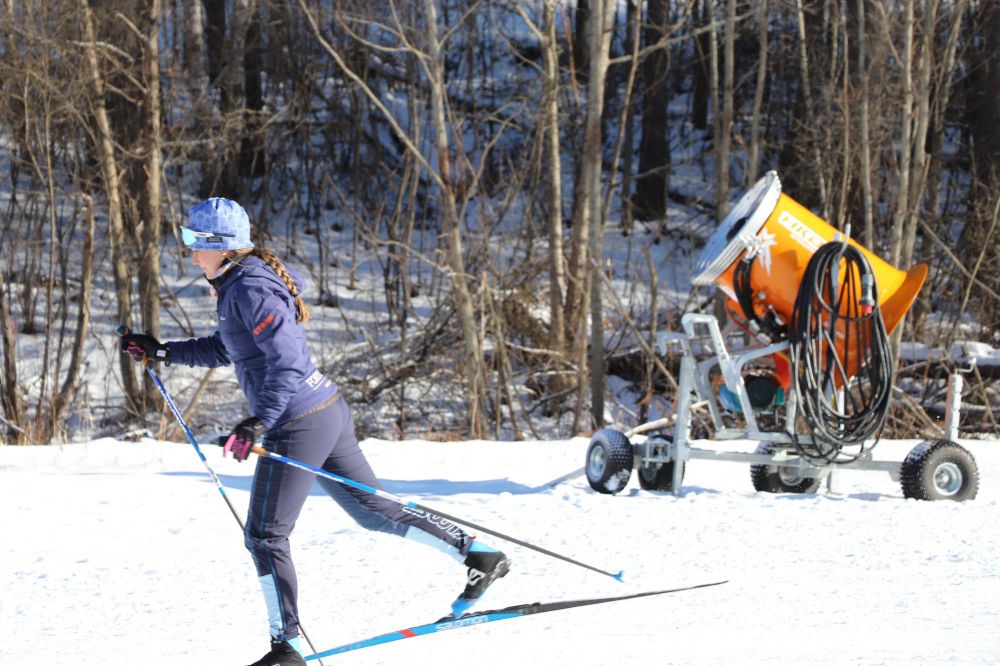
Lebanon High School sophomore Annie Hanna skis on manmade snow at Oak Hill Outdoor Center in January. (Photo: Beatrice Burack)
This season, her team has frequently made the two-hour drive to Craftsbury, Vermont, in search of snow. During a late November training session before an important race, they ended up at Rikert Nordic Center in Ripton, Vermont, where they spent five hours “just circling” a 300-meter loop of snow. “It was really repetitive,” Hanna says. “But it was good to be on snow.”
Milliken, once a collegiate nordic ski racer, has found himself spending more and more time skiing on small loops like that one over the years. He compares it to swimming laps indoors at a swimming pool.
When designing the three-kilometer loop for Oak Hill, he tried to address this by asking, “‘How can we make three kilometers as interesting as possible?” The goal, he says, was, “you’re going to want to come here in the winter when there’s only snow in the snowmaking course and you’re going to want to hang out with some friends and say, ‘Hey, let’s go and do three or four laps, and that’ll be fun.’” Which, as this winter developed, was pretty much what happened: Though there were times when Oak Hill’s entire trail network was open, by the end of February, skiing had narrowed to the man-made loop and a few nearby trails. On the other hand, that was exactly what the state high school nordic skiing championships needed in early March: A lack of snow elsewhere led the NHIAA (the NH Interscholastic Athletic Association) to move the Division I and II championships to Oak Hill’s manmade loop.
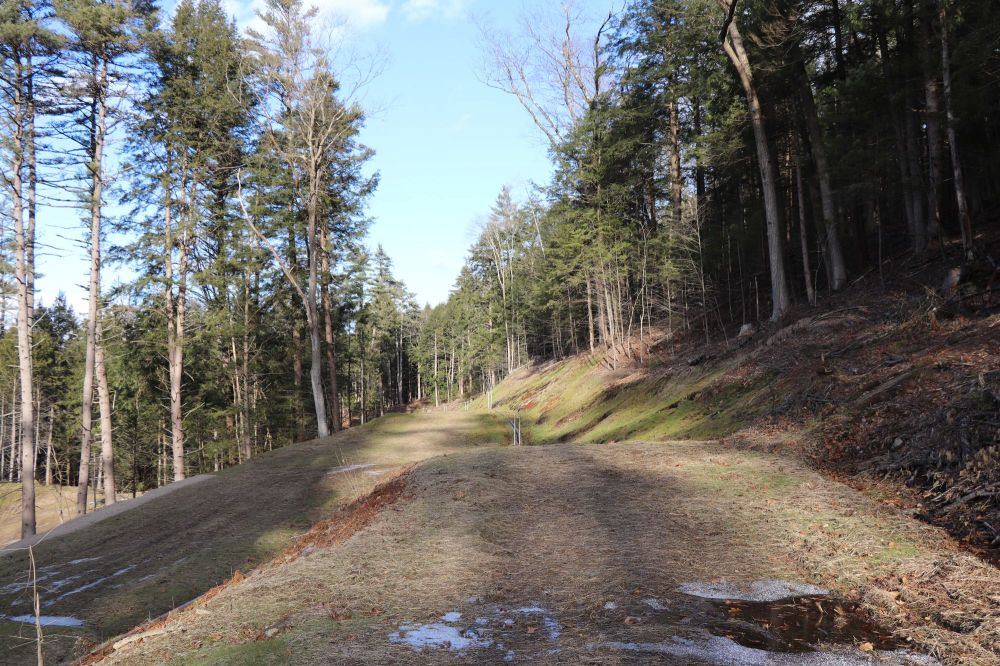 Trails at Oak Hill on December 13, 2023, before the center’s new snowmaking system was completed. (Photo: Beatrice Burack)
Trails at Oak Hill on December 13, 2023, before the center’s new snowmaking system was completed. (Photo: Beatrice Burack)
For Hanna, who has placed in the top 10 in every individual race she's entered at Junior Nationals in the last two years, shorter loops and a heavier reliance on snowmaking are “just the new reality of nordic skiing.” The changes at Oak Hill are “bittersweet,” she says.
“It’s really a special thing that we have the equipment and facilities to be able to keep using these trails, but it is sad to think about [how we] used to be able to go outside any day in the winter and go ski. That’s not really the case anymore.”
Beatrice Burack is a Granite State native and a junior at Dartmouth College working as a freelance journalist in the Upper Valley. Her work has appeared in the New Hampshire Bulletin*, NHPR,* NH Business Review*, and the* Valley News*, among other publications. She can be reached at bea.c.burack.25@dartmouth.edu. Her exhibit on NH skiing in the age of climate change opens in Reiss Hall in Dartmouth’s Baker Library on Monday, March 11th. It will stay up through May.*
These stories were first published in Daybreak, an email newsletter focused on the Upper Valley, New Hampshire, and Vermont, and are being shared with the partners in The Granite State News Collaborative.

 Current Issue - July 2024
Current Issue - July 2024